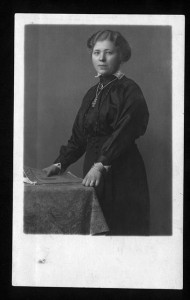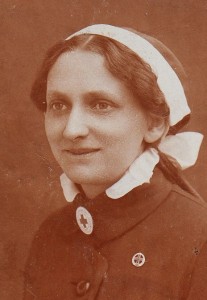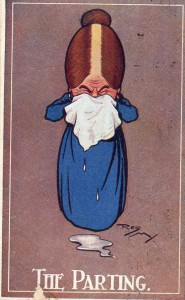March 8th is International Women’s Day, an event that is celebrated in some parts of the World and virtually unknown in others. We would like to mark the occasion by pointing to a small sample of stories in the Europeana 1914-1918 collection. The format of the ‘stories’ varies – some are long, detailed, and richly illustrated while others are brief and may consist of only one image and a line or two of text. What they have in common though is that they all tell us something about women’s life during the time of the First World War. All the material is shared by members of the public who have added them to the archive either online or at a collection event. To see these stories, and many, many more, visit the http://europeana1914-1918.eu/ website.
Hulda Framers – grieving fiancée
This picture shows Hulda Framers. Around her neck is a chain on which she carries an engagement ring and an iron cross, presumably those of her fallen fiancée.
Maria Mohr (nee Steiner) was born in Silesia in 1888. In 1911 she married the actor and director Ludwig Mohr from Bohemia and thus became a citizen of the Habsburg monarchy. Shortly after the birth and death of their son, Ludwig Mohr was drafted to the army. He was killed in Drenovac, Serbia in October 1914. Maria worked as a Red Cross nurse in the war hospital Grinzing, Vienna from 1916. Between May 1918 to September 1919 she managed a girl’s home for the Army with about 50-60 girls. She got engaged to an officer in 1918, but he died and was buried in Levico.
Maria returned to Silesia in 1919, after the war. Through her work in the hospital she had contracted tuberculosis, and she spent some time in a clinic recovering. She then lived with her father, kept house for him and worked as an accountant. After the Second World War, when Silesia became Polish, Maria fled to Emsland to the family of her niece Elfriede, where she lived until her death in 1954.
To read the whole story (in German) and see all the accompanying images and documents, go to the Europeana 1914-1918 site: http://www.europeana1914-1918.eu/en/contributions/13965 Contributed by Erika Brieske CC BY-SA.
Women’s correspondence with secret codes
Whilst the men were away fighting a number of my great, great aunt’s friends, who were all young women between 18 and 25 years of age, corresponded with one another by postcard, many of which show contemporary cartoons. They sent them for birthdays and to cheer one another up as well as to discuss every day life. The messages they wrote on the postcards were very basic and said very little, but I understand they developed a code to share messages, for example about news they had from soldiers overseas, or about other matters they did not want either the postman or the censor to see.
To read the whole story, and see more cards, go to http://www.europeana1914-1918.eu/en/contributions/4317


